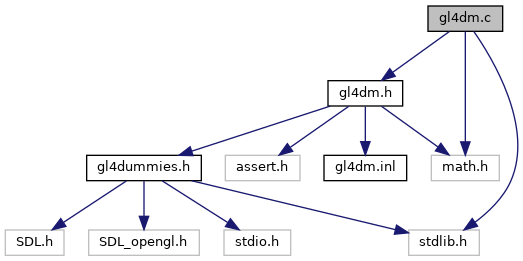fonctions liées aux calculs mathématiques propres à l'utilisation de GL4Dummies. Plus de détails...

Aller au code source de ce fichier.
Fonctions | |
| double | gl4dmURand (void) |
| Retourne un nombre pseudo-aleatoire dans l'intervalle [0, 1[. Ici la distribution est uniforme. Plus de détails... | |
| double | gl4dmSURand (void) |
| Retourne un nombre pseudo-aleatoire dans l'intervalle [-1, 1[. Ici la distribution est uniforme. Plus de détails... | |
| double | gl4dmGRand (void) |
| Retourne un nombre pseudo-aleatoire dans l'intervalle ]-7, +7[. Ici la distribution est Gaussienne. Plus de détails... | |
| double | gl4dmGURand (void) |
| Retourne un nombre pseudo-aleatoire dans l'intervalle [-1, +1[. Ici la distribution est Gaussienne centrée en zéro. Plus de détails... | |
| static GLfloat | hurst (GLfloat d, GLfloat H) |
| static void | triangle_edge (GLfloat *im, int x, int y, int w, int h, int width, GLfloat ri, GLfloat H) |
| GLfloat * | gl4dmTriangleEdge (GLuint width, GLuint height, GLfloat H) |
| génère une heightmap en utilisant l'algorithme du triangle-edge. Les valeurs retournées dans la map sont comprises entre 0 et 1. Plus de détails... | |
Description détaillée
fonctions liées aux calculs mathématiques propres à l'utilisation de GL4Dummies.
- Date
- November 12, 2014
Définition dans le fichier gl4dm.c.
Documentation des fonctions
◆ gl4dmGRand()
| double gl4dmGRand | ( | void | ) |
Retourne un nombre pseudo-aleatoire dans l'intervalle ]-7, +7[. Ici la distribution est Gaussienne.
Tire du knuth : le rand Gaussien a deux valeurs par passe deux rand : X1 et X2.
- Renvoie
- un nombre pseudo-aleatoire selon une distribution gaussienne dans l'intervalle ]-7, +7[ (expérimentalement dans [-6.997568, 6.882738])
Référencé par gl4dmGURand().
◆ gl4dmGURand()
| double gl4dmGURand | ( | void | ) |
Retourne un nombre pseudo-aleatoire dans l'intervalle [-1, +1[. Ici la distribution est Gaussienne centrée en zéro.
- Renvoie
- un nombre pseudo-aleatoire selon une distribution gaussienne dans l'intervalle ]-1, +1[
Références gl4dmGRand().
◆ gl4dmSURand()
| double gl4dmSURand | ( | void | ) |
Retourne un nombre pseudo-aleatoire dans l'intervalle [-1, 1[. Ici la distribution est uniforme.
- Renvoie
- un nombre pseudo-aleatoire dans l'intervalle [-1, 1[.
Référencé par setDimensions(), et triangle_edge().
◆ gl4dmTriangleEdge()
| GLfloat* gl4dmTriangleEdge | ( | GLuint | width, |
| GLuint | height, | ||
| GLfloat | H | ||
| ) |
génère une heightmap en utilisant l'algorithme du triangle-edge. Les valeurs retournées dans la map sont comprises entre 0 et 1.
- Paramètres
-
width la largeur de la heightmap height la hauteur de la heightmap H exposant de Hurst, permet de controler la dimension fractale de la heightmap. La valeur standard est 0.5 (sinon entre 0 et 1)
- Renvoie
- la heightmap allouée/générée et qu'il faudra libérer avec free.
Références GL4DM_EPSILON, gl4dmURand(), et triangle_edge().
◆ gl4dmURand()
| double gl4dmURand | ( | void | ) |
Retourne un nombre pseudo-aleatoire dans l'intervalle [0, 1[. Ici la distribution est uniforme.
- Renvoie
- un nombre pseudo-aleatoire dans l'intervalle [0, 1[.
Référencé par gl4dmTriangleEdge().
◆ hurst()
|
inlinestatic |
Référencé par triangle_edge().
◆ triangle_edge()
|
static |
